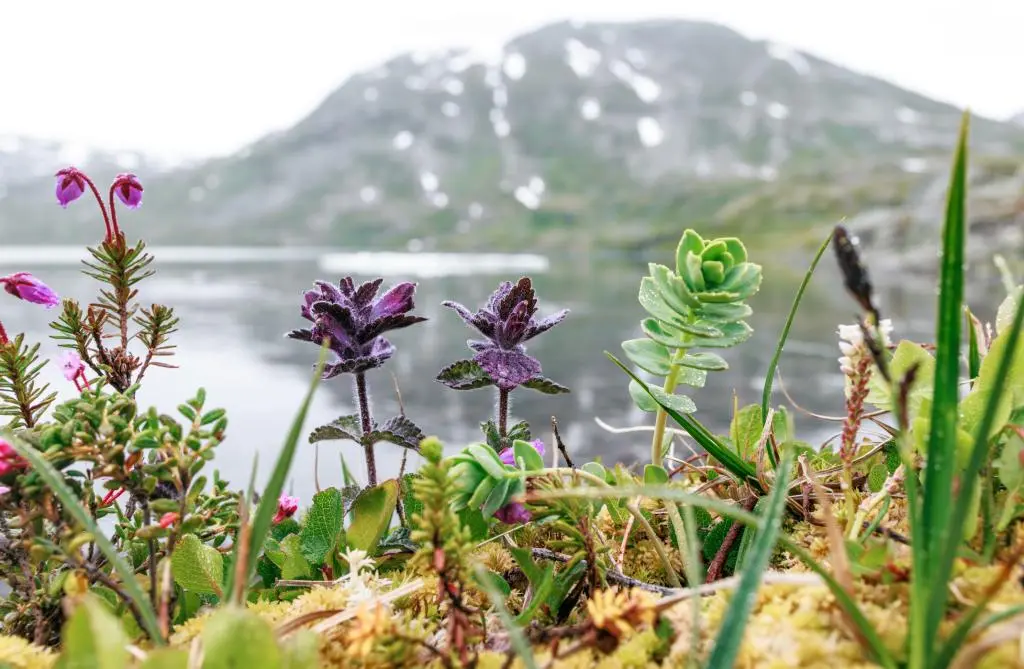About Tundra Ecosystem
- Tundra ecosystems are treeless regions found in the Arctic and on the tops of mountains, where the climate is cold and windy, and rainfall is scant.
- Characteristics of Tundra Regions
- Low temperatures: The average temperature is -34 to -6 degrees Celsius (-30 to 20 degrees Fahrenheit) in tundra region.
- Short growing seasons: The summer growing season is just 50 to 60 days, when the sun shines up to 24 hours a day.
- Permafrost: A layer of permanently frozen soil lies beneath the surface, which can be a few inches to several feet thick.
- Minimal precipitation: Despite often being compared to deserts in terms of moisture, the tundra receives low levels of precipitation, often as snow.
- Limited biodiversity: The harsh conditions of the tundra result in fewer plant and animal species compared to other biomes.
- Carbon sink: The tundra acts as a significant carbon storage area due to slow decomposition rates in the cold environment.
- The world has three types of tundra:
- Arctic Tundra which occurs north of the taiga belt in the far Northern Hemisphere (It encompasses the land between the North Pole and the boreal forest, including parts of Canada, Russia, Greenland, Iceland, Norway, Sweden, and Finland.)
- Alpine tundra which prevails above the tree line in mountains worldwide (in various mountain ranges such as the Rockies, the Andes, the Himalayas, and the Alps).
- Antarctic tundra which includes several sub-Antarctic islands and parts of the continent of Antarctica
- Flora: Mosses, lichens, sedges, cotton grass, birches etc.
Fauna: Arctic foxes, snow geese, polar bears etc.
Q1) What is the Arctic Council?
The Arctic Council is an intergovernmental forum for discussing and addressing issues concerning the Arctic region. These include scientific research and peaceful and sustainable use of resources in the region. The Council was established by the 8 Arctic States through the Ottawa Declaration of 1996.
Source: Warming planet may transform tundra ecosystems from carbon sinks to sources
Last updated on November, 2025
→ Check out the latest UPSC Syllabus 2026 here.
→ Join Vajiram & Ravi’s Interview Guidance Programme for expert help to crack your final UPSC stage.
→ UPSC Mains Result 2025 is now out.
→ UPSC Notification 2026 is scheduled to be released on January 14, 2026.
→ UPSC Calendar 2026 is released on 15th May, 2025.
→ The UPSC Vacancy 2025 were released 1129, out of which 979 were for UPSC CSE and remaining 150 are for UPSC IFoS.
→ UPSC Prelims 2026 will be conducted on 24th May, 2026 & UPSC Mains 2026 will be conducted on 21st August 2026.
→ The UPSC Selection Process is of 3 stages-Prelims, Mains and Interview.
→ UPSC Result 2024 is released with latest UPSC Marksheet 2024. Check Now!
→ UPSC Prelims Result 2025 is out now for the CSE held on 25 May 2025.
→ UPSC Toppers List 2024 is released now. Shakti Dubey is UPSC AIR 1 2024 Topper.
→ UPSC Prelims Question Paper 2025 and Unofficial Prelims Answer Key 2025 are available now.
→ UPSC Mains Question Paper 2025 is out for Essay, GS 1, 2, 3 & GS 4.
→ UPSC Mains Indian Language Question Paper 2025 is now out.
→ UPSC Mains Optional Question Paper 2025 is now out.
→ Also check Best IAS Coaching in Delhi

















